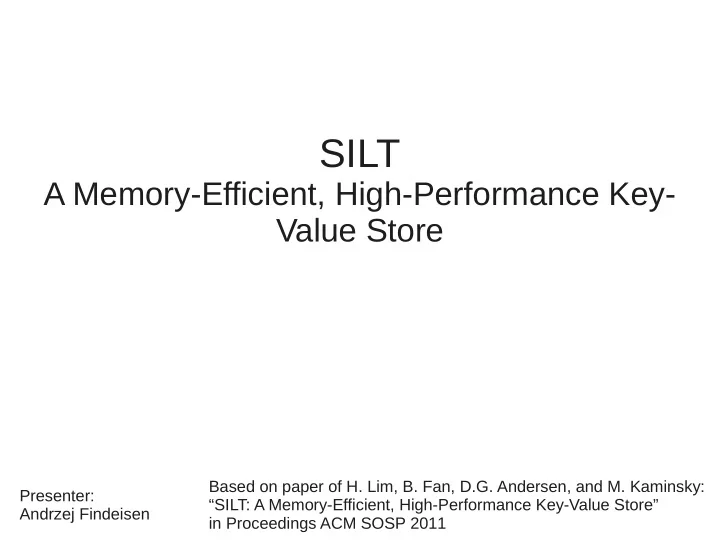

SILT A Memory-Efficient, High-Performance Key- Value Store Based on paper of H. Lim, B. Fan, D.G. Andersen, and M. Kaminsky: Presenter: “SILT: A Memory-Efficient, High-Performance Key-Value Store” Andrzej Findeisen in Proceedings ACM SOSP 2011
Introduction
Abstract ● SILT = Small Index Large Table ● System for storing key-value pairs ● Extremely efficient in terms of memory and flash disk usage – 0.7 bytes of DRAM per entry – 1.01 flash reads per entry retrieval – Writing optimized for flash specific characteristics ● Assumption: uniformly distributed 160-bit keys
Rationale Moreover DRAM is: ● 8 times more expensive than flash disk ● 25 times power consuming than flash disk
Comparison
Goals ● Low read amplification: Issue at most 1 + ε flash reads for a single GET where ε is configurable and small (e.g. 0.01). ● Controllable write amplification and favoring sequential writes: The system should issue flash-friendly, large writes. ● Memory-efficient indexing: SILT should use as little memory as possible. ● Computation-efficient indexing: SILT’s indexes should be fast enough to let the system saturate the flash I/O. ● Effective use of flash space: Some data layout options use the flash space more sparsely to improve lookup or insertion speed, but the total space overhead of any such choice should remain small – less than 20% or so.
Design
Architecture
LogStore
HashStore
SortedStore I
SortedStore II Trie representation ● Repr(T) := |L| Repr(L) Repr(R) ● Entropy coding ● Worst case: scanning whole trie ● Therefore 2 k buckets are introduced (ex. k = 10 for 2 16 items)
Performance
Overheads
Flash disk usage ● Data written to flash in bigger chunks ● Example – 256 GB disk, 10k erase cycles, 100M items, 4 SILT instances, 7.5M entries to merge, 1KiB entries, 5k updates per second – WA = 5.4, 31 of HashStores (RA = 1.008), 102.4GB of data, 73MB of DRAM – Device will last 3 years
Memory usage and throughput
Latency
Throughput
Thank you Q&A
Recommend
More recommend